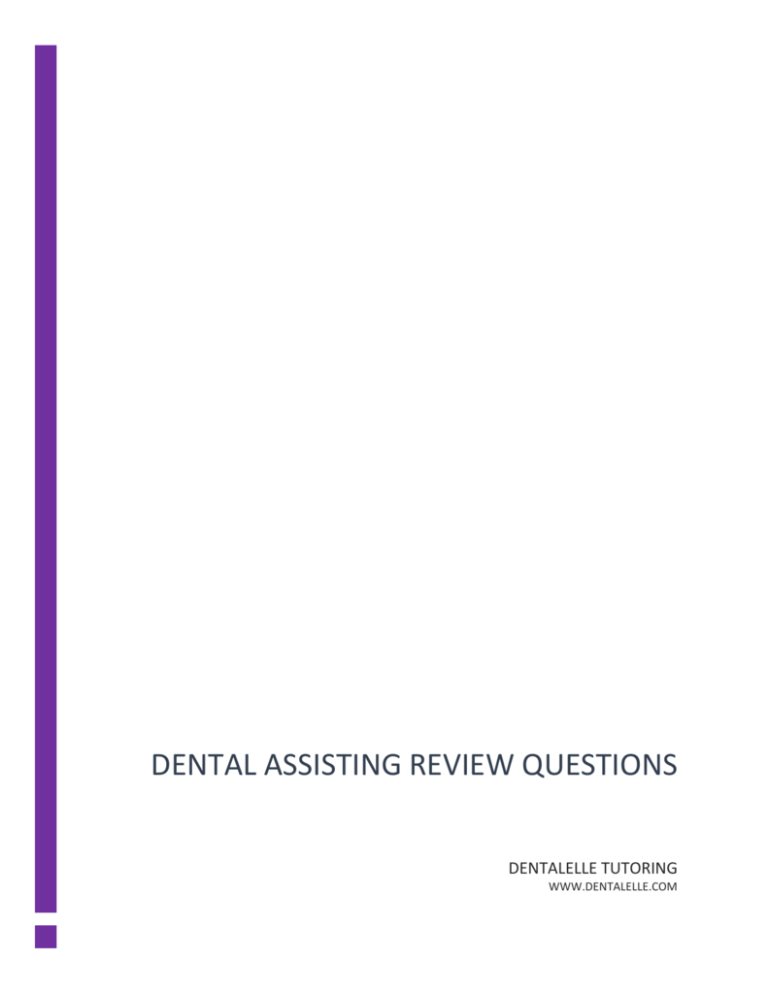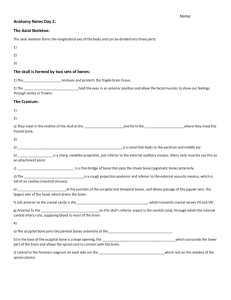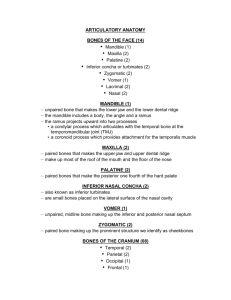File - Dentalelle Tutoring
advertisement

DENTAL ASSISTING REVIEW QUESTIONS DENTALELLE TUTORING WWW.DENTALELLE.COM Dental Assisting Session Two QUESTIONS 1. 2. 3. 4. 5. 6. 7. 8. 9. 10. 11. 12. 13. 14. 15. 16. 17. 18. 19. 20. 21. 22. 23. Where is the Mid-Sagittal Suture and Lambdoid Suture? Where is the occipital bone? Where are the lesser and greater wings? Where is the optic foramen? What is the Crista Galli? What are the smallest and most fragile facial bones? What is the inferior nasal concha? What is a flat bone? What is a ‘U’ shaped bone? What is the muscle that contracts the condyle is pulled forward and down producing mouth opening? What is normal blood pressure? What is normal respiration and pulse? What is hypertension and hypotension? How should the dental assistant be seated? What are the five categories of motion? What must the dental assistant know about ‘zones?’ What are the steps for sealant placement? What are inlays and onlays? What is gutta percha? What are some causes of acquired malocclusions? What are some causes of recession? What is the difference between intrinsic and extrinsic staining? What is something that develops in about 3% to 4% of all extractions? This occurs when a blood clot doesn't form in the hole or the blood clot breaks off or breaks down too early. Dental Assisting Session Two ANSWERS 1. Where is the Mid-Sagittal Suture and Lambdoid Suture? The sagittal suture is a dense, fibrous connective tissue joint between the two parietal bones of the skull. At birth, the bones of the skull do not meet. If certain bones of the skull grow too fast then "premature closure" of the sutures may occur. This can result in skull deformities. If the sagittal suture closes early the skull becomes long, narrow, and wedge-shaped, a condition called scaphocephaly. The lambdoid suture (or lambdoidal suture) is a dense, fibrous connective tissue joint on the posterior aspect of the skull that connects the parietal bones with the occipital bone. The parietals articulate with each other by way of the Mid-Sagittal Suture, and with the frontal bone anteriorly by way of the Coronal Suture. 2. What is the occipital bone? The Occipital Bone consists of a large squamous, or flattened portion separated from a small thick basal portion by the Foramen Magnum on either side of which is a left or right Occipital Condyle. 3. Where are the lesser and greater wings? The Sphenoid has a number of features and projections, which allow it to be seen from various views of the skull. It is a single bone that runs through the mid-sagittal plane and aids to connect the cranial skeleton to the facial skeleton. It consists of a hollow body, which contains the Sphenoidal Sinus, and three pairs of projections: the more superior Lesser Wings, the intermediate Greater Wings, and the most inferior projecting Pterygoid Processes. 4. Where is the optic foramen? The smaller lesser wings possesses the Optic Foramen through which the optic or second cranial nerve passes before giving rise to the eye. 5. Where is the Critsa Galli? The Ethmoid has a number of features and projections, but unlike the sphenoid it cannot be seen from various views of the skull. It is a single bone that runs through the mid-sagittal plane and aids to connect the cranial skeleton to the facial skeleton. It consists of various plates and paired projections. The most superior projection is the Crista Galli, found within the cranium. It assists in dividing the left and right frontal lobes of the brain. Lateral projections from the Crista Galli are the left and right Cribriform Plates which in life cradle the first cranial nerves i.e., the olfactory nerves. 6. What are the smallest and most fragile facial bones? The Lacrimal bones are the smallest and most fragile of the facial bones. They are paired left and right and assist in forming the anterior portion of the medial wall of each eye orbit. They are basically rectangular with two surfaces and four borders. Each of the borders articulate with the bones that surround the Lacrimal. 7. What is the inferior nasal concha? The Inferior Nasal Concha is a very thin, porous, and fragile, paired bone basically elongated and curled upon itself. It lays in the horizontal plane and is attached to the lateral wall of the nasal cavity. By way of the Maxillary Process on the bones lateral surface, it is attached to the maxilla, and by way of the Lacrimal, Ethmoid and Palatine Processes to each of the bones which assist in forming the lateral wall of the nasal cavity. 8. What is a flat bone? The Vomer is a single relatively flat bone located in the mid-sagittal plane. It articulates with the perpendicular plate of the Ethmoid superiorly and together aid in forming the nasal septum. While it is frequently deflected slightly to the left or right, in general the septum is aligned perpendicularly and divides the nasal aperture into the left and right nasal passages. 9. What is a ‘U’ shaped bone? The hyoid is a single small "U" shaped bone in the adult which does not articulate with any other bone. It is suspended from the styloid process of each temporal bone by means of the stylohyoid ligaments. It is located in the mid-sagittal plane, at the front of the throat, and beneath the mandible but above the larynx near the level of the third cervical vertebrae. It is formed from three separate parts (i.e., the Body, and the left and right Greater and Lesser Cornu) which fuse in early adulthood. The base of the "U" shaped bone is located anteriorly while the Cornu project posteriorly. 10. What is the muscle that contracts the condyle is pulled forward and down producing mouth opening? Lateral pterygoid muscle - when this muscle contracts the condyle is pulled forward and down producing mouth opening. 11. What is normal blood pressure? 115/75 or 120/80 – depends on the textbook you read . Both are considered normal. 12. What is normal respiration and pulse? 14-20 respirations and normal pulse is 60-90 bpm. 13. What is hypertension and hypotension? Hypertension is high blood pressure and hypotension is low bleed pressure. With hypertension sometimes treatment is changing the diet (less salt!) and exercise or medications may also be needed. 14. How should the dental assistant be seated? Neutral-sitting position is ideal. This is sitting upright with your back straight and weight evenly distributed over the seat. Legs should be slightly separated with feet flat on the ring around the base of the chair. Your thighs should be parallel to the floor and front edge of the chair even with the patient's mouth. Position your chair close to the side of the patient with knees facing toward the patient's head. The height of the chair should be such that your eye level is 4 to 6 inches above the operator. This will give you a good line of vision into all areas of the patient's mouth. If your chair has an arm support, it should be at the level of your abdomen and be used for reaching and leaning forward. The position of the mobile cart or cabinet top should be over your thighs and as close as possible. 15. What are the five categories of motion? Class I is using fingers only such as flipping ends of the instrument. Class II is using fingers and wrist. This could be transferring an instrument to the operator. Movement of fingers, wrist and arm are Class III. Oral evacuation is in this classification. Mixing of dental materials involves movement of the entire arm and shoulder. This is classified as Class IV. Class V is movement of the arm and twisting of the body. Twisting behind you to adjust the dental light would be this classification. 16. What must the dental assistant know about ‘zones?’ The work area around the patient is arranged into zones representing hours on a clock. The activity zone for the operator is 7 o'clock to 12 o'clock. All activities of the operator at the Chairside are performed in this zone. The assisting zone is 2 o'clock to 4 o'clock. In this zone, the assistant is positioned. The assistant transfers materials and instruments in the transfer zone, which is 4 o'clock to 7 o'clock. 17. What are the steps for sealant placement? Wash the tooth with pumice and water to ensure it is clean Wash and dry the tooth Apply your cotton rolls, dry angles, etc. to the area Apply etch and allow to sit for 10-30 seconds depending on the manufacturer’s instructions Wash the etch very well, dry very well. To ensure proper etching has taken place, the tooth must appear a chalky white and if not, re-etch for 10-20 seconds Apply the sealant material Run an explorer along the sealant to prevent air bubbles from forming Light cure for 10-20 seconds Check sealant with explorer to make sure no voids are present Use bite paper to check the bite (articulation), if the sealant is high, the Dentist can smooth off with a high speed hand piece 18. What are inlays and onlays? Made indirectly (in a lab) and onlays go ‘on top’ of the tooth and involve the cusps, when inlays go inside the tooth and do not involve the cusps. 19. What is gutta percha? Used inside the canal of the tooth to fill it, used in root canal procedures. 20. What are some causes of acquired malocclusions? Trauma (including delayed weaning from thumb, finger, or pacifier sucking) Mouth breathing (due to enlarged tonsils or adenoids, blocked nasal passages etc.) Premature loss of baby or adult teeth 21. What are some causes of recession? The most common cause is brushing the teeth too hard, and over time recession can result. An EXTRA soft toothbrush is recommended for those who brush too hard and currently have recession 22. What is the difference between intrinsic and extrinsic staining? Intrinsic staining is stain ‘within’ the tooth and cannot be brushed away. Extrinsic stain is stain ‘outside’ the tooth and can be polished or cleaned away. 23. What is something that develops in about 3% to 4% of all extractions? This occurs when a blood clot doesn't form in the hole or the blood clot breaks off or breaks down too early. A dry socket. Dry socket occurs up to 30% of the time when impacted teeth are removed. It is also more likely after difficult extractions. Smokers and women who take birth control pills are more likely to have a dry socket. A dry socket needs to be treated with a medicated dressing to stop the pain and encourage the area to heal. Infection can set in after an extraction. However, you probably won't get an infection if you have a healthy immune system.









